Application of Criminal Justice Stages: A Case Study of Travis's Crime
VerifiedAdded on 2023/06/09
|10
|2330
|151
Essay
AI Summary
This essay provides an overview of the criminal justice process, applying each stage to a hypothetical case involving an individual named Travis, who is accused of child abuse. The analysis begins with the initial investigation and arrest, detailing the importance of probable cause and evidence gathering. It then proceeds through prosecution, indictment, arraignment, pretrial detention, and plea bargaining, explaining the roles of the district attorney, grand jury, and judge. The essay further examines the trial, sentencing, and appeals processes, highlighting the burden of proof and potential outcomes. Finally, it touches on punishment and rehabilitation, considering various forms of correctional authority and release mechanisms. The conclusion emphasizes the need for a thorough and just legal process to determine guilt or innocence, referencing both the strengths and weaknesses of the evidence against Travis in relation to the child abuse allegations.
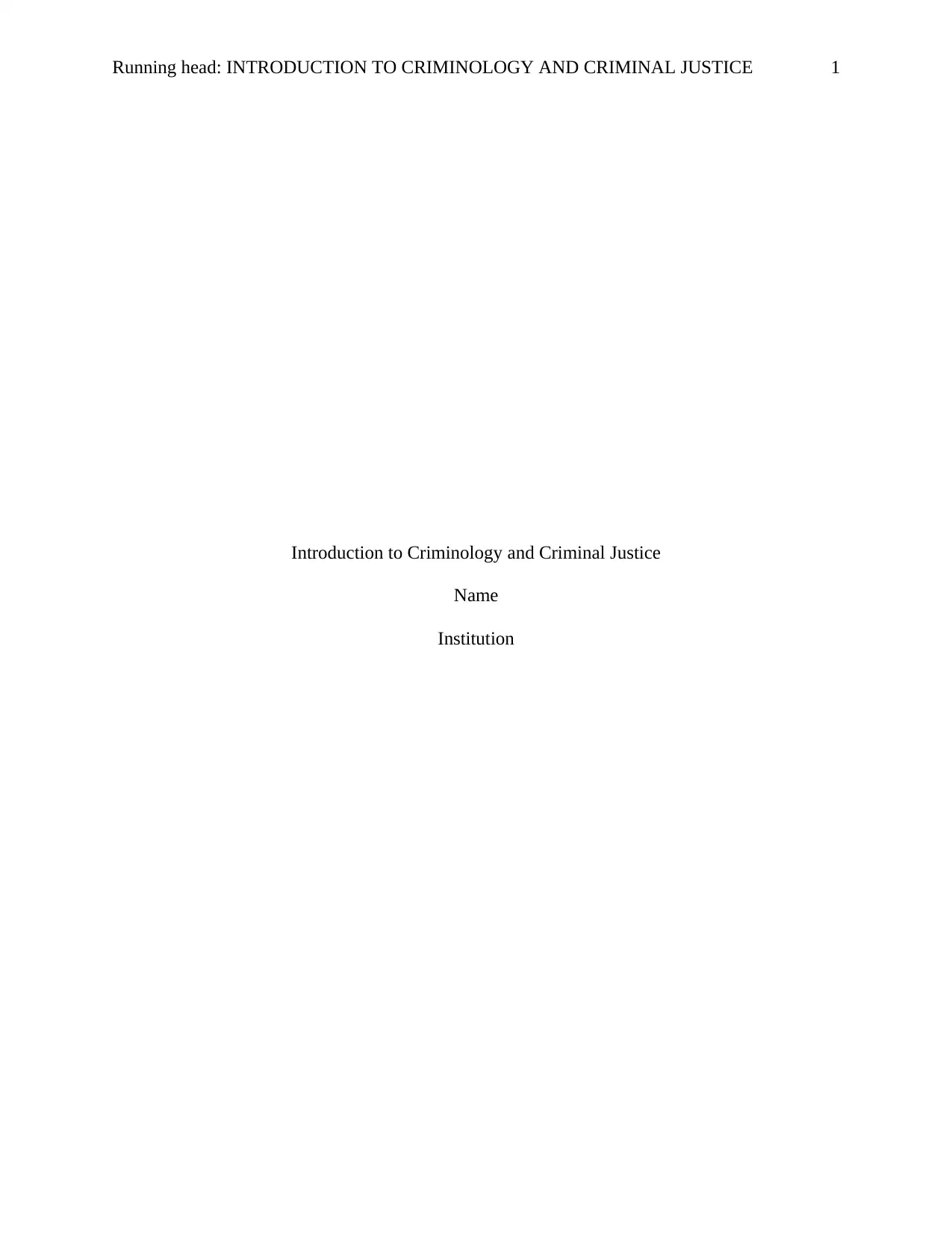
Running head: INTRODUCTION TO CRIMINOLOGY AND CRIMINAL JUSTICE 1
Introduction to Criminology and Criminal Justice
Name
Institution
Introduction to Criminology and Criminal Justice
Name
Institution
Paraphrase This Document
Need a fresh take? Get an instant paraphrase of this document with our AI Paraphraser
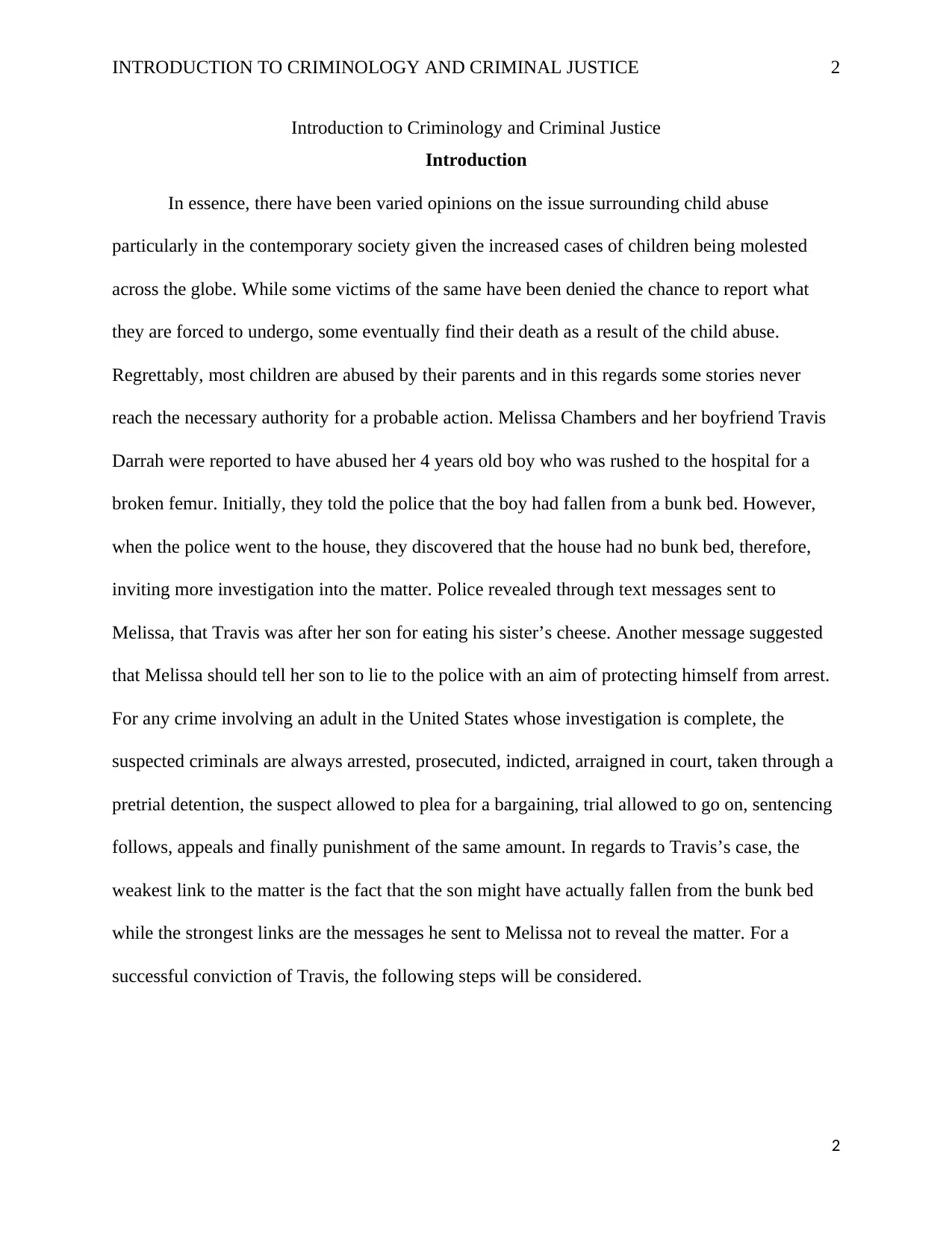
INTRODUCTION TO CRIMINOLOGY AND CRIMINAL JUSTICE 2
Introduction to Criminology and Criminal Justice
Introduction
In essence, there have been varied opinions on the issue surrounding child abuse
particularly in the contemporary society given the increased cases of children being molested
across the globe. While some victims of the same have been denied the chance to report what
they are forced to undergo, some eventually find their death as a result of the child abuse.
Regrettably, most children are abused by their parents and in this regards some stories never
reach the necessary authority for a probable action. Melissa Chambers and her boyfriend Travis
Darrah were reported to have abused her 4 years old boy who was rushed to the hospital for a
broken femur. Initially, they told the police that the boy had fallen from a bunk bed. However,
when the police went to the house, they discovered that the house had no bunk bed, therefore,
inviting more investigation into the matter. Police revealed through text messages sent to
Melissa, that Travis was after her son for eating his sister’s cheese. Another message suggested
that Melissa should tell her son to lie to the police with an aim of protecting himself from arrest.
For any crime involving an adult in the United States whose investigation is complete, the
suspected criminals are always arrested, prosecuted, indicted, arraigned in court, taken through a
pretrial detention, the suspect allowed to plea for a bargaining, trial allowed to go on, sentencing
follows, appeals and finally punishment of the same amount. In regards to Travis’s case, the
weakest link to the matter is the fact that the son might have actually fallen from the bunk bed
while the strongest links are the messages he sent to Melissa not to reveal the matter. For a
successful conviction of Travis, the following steps will be considered.
2
Introduction to Criminology and Criminal Justice
Introduction
In essence, there have been varied opinions on the issue surrounding child abuse
particularly in the contemporary society given the increased cases of children being molested
across the globe. While some victims of the same have been denied the chance to report what
they are forced to undergo, some eventually find their death as a result of the child abuse.
Regrettably, most children are abused by their parents and in this regards some stories never
reach the necessary authority for a probable action. Melissa Chambers and her boyfriend Travis
Darrah were reported to have abused her 4 years old boy who was rushed to the hospital for a
broken femur. Initially, they told the police that the boy had fallen from a bunk bed. However,
when the police went to the house, they discovered that the house had no bunk bed, therefore,
inviting more investigation into the matter. Police revealed through text messages sent to
Melissa, that Travis was after her son for eating his sister’s cheese. Another message suggested
that Melissa should tell her son to lie to the police with an aim of protecting himself from arrest.
For any crime involving an adult in the United States whose investigation is complete, the
suspected criminals are always arrested, prosecuted, indicted, arraigned in court, taken through a
pretrial detention, the suspect allowed to plea for a bargaining, trial allowed to go on, sentencing
follows, appeals and finally punishment of the same amount. In regards to Travis’s case, the
weakest link to the matter is the fact that the son might have actually fallen from the bunk bed
while the strongest links are the messages he sent to Melissa not to reveal the matter. For a
successful conviction of Travis, the following steps will be considered.
2
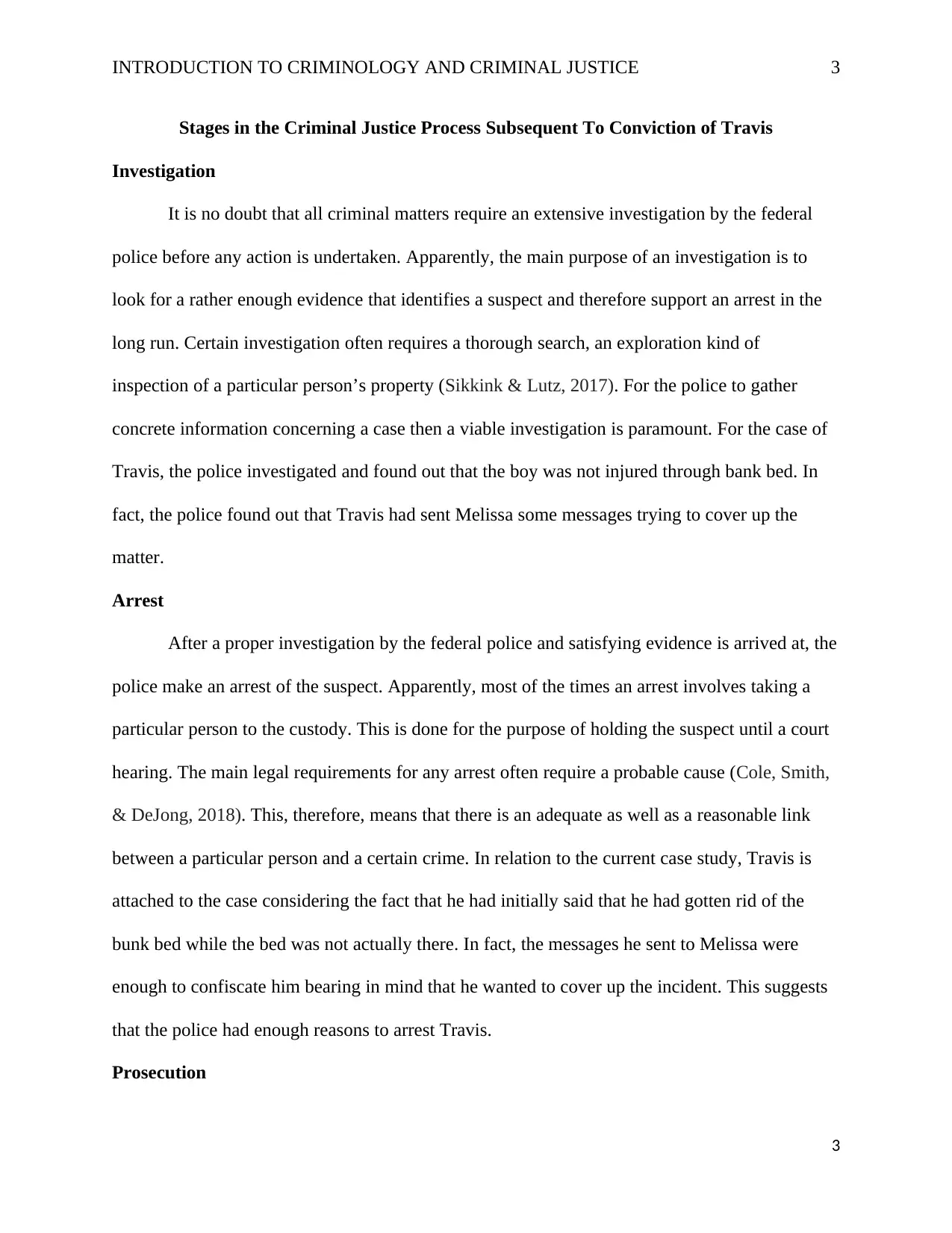
INTRODUCTION TO CRIMINOLOGY AND CRIMINAL JUSTICE 3
Stages in the Criminal Justice Process Subsequent To Conviction of Travis
Investigation
It is no doubt that all criminal matters require an extensive investigation by the federal
police before any action is undertaken. Apparently, the main purpose of an investigation is to
look for a rather enough evidence that identifies a suspect and therefore support an arrest in the
long run. Certain investigation often requires a thorough search, an exploration kind of
inspection of a particular person’s property (Sikkink & Lutz, 2017). For the police to gather
concrete information concerning a case then a viable investigation is paramount. For the case of
Travis, the police investigated and found out that the boy was not injured through bank bed. In
fact, the police found out that Travis had sent Melissa some messages trying to cover up the
matter.
Arrest
After a proper investigation by the federal police and satisfying evidence is arrived at, the
police make an arrest of the suspect. Apparently, most of the times an arrest involves taking a
particular person to the custody. This is done for the purpose of holding the suspect until a court
hearing. The main legal requirements for any arrest often require a probable cause (Cole, Smith,
& DeJong, 2018). This, therefore, means that there is an adequate as well as a reasonable link
between a particular person and a certain crime. In relation to the current case study, Travis is
attached to the case considering the fact that he had initially said that he had gotten rid of the
bunk bed while the bed was not actually there. In fact, the messages he sent to Melissa were
enough to confiscate him bearing in mind that he wanted to cover up the incident. This suggests
that the police had enough reasons to arrest Travis.
Prosecution
3
Stages in the Criminal Justice Process Subsequent To Conviction of Travis
Investigation
It is no doubt that all criminal matters require an extensive investigation by the federal
police before any action is undertaken. Apparently, the main purpose of an investigation is to
look for a rather enough evidence that identifies a suspect and therefore support an arrest in the
long run. Certain investigation often requires a thorough search, an exploration kind of
inspection of a particular person’s property (Sikkink & Lutz, 2017). For the police to gather
concrete information concerning a case then a viable investigation is paramount. For the case of
Travis, the police investigated and found out that the boy was not injured through bank bed. In
fact, the police found out that Travis had sent Melissa some messages trying to cover up the
matter.
Arrest
After a proper investigation by the federal police and satisfying evidence is arrived at, the
police make an arrest of the suspect. Apparently, most of the times an arrest involves taking a
particular person to the custody. This is done for the purpose of holding the suspect until a court
hearing. The main legal requirements for any arrest often require a probable cause (Cole, Smith,
& DeJong, 2018). This, therefore, means that there is an adequate as well as a reasonable link
between a particular person and a certain crime. In relation to the current case study, Travis is
attached to the case considering the fact that he had initially said that he had gotten rid of the
bunk bed while the bed was not actually there. In fact, the messages he sent to Melissa were
enough to confiscate him bearing in mind that he wanted to cover up the incident. This suggests
that the police had enough reasons to arrest Travis.
Prosecution
3
⊘ This is a preview!⊘
Do you want full access?
Subscribe today to unlock all pages.

Trusted by 1+ million students worldwide

INTRODUCTION TO CRIMINOLOGY AND CRIMINAL JUSTICE 4
This process often involves a district attorney prosecuting a particular criminal defendant.
Apparently, prosecutors have to weigh various factors such as the level of seriousness of the
offense as well as the strength of a set of evidence before deciding whether to charge an
individual. In the case of Travis, the district attorney will highly rely on the pieces of evidence
and the seriousness of the gathered information particularly from the messages to Melissa when
deciding if he or she can prosecute him (Roberts, 2018).
Indictment
In essence, this process is often undertaken by the grand jury where filling of information
is viable by a particular prosecutor. In most instances, an indictment occurs when there is a
prosecution of capital offenses as defined by the federal rules of criminal procedure.in this
regards, the prosecutor has the option of an indictment or a rather relevant information in a
certain case that involves crimes that are punishable by imprisonment. In most states in the
United States nearly a half, a grand jury hugely decides on whether to bring a particular charge
against an individual in a rather closed hearing where the prosecutor is the only person allowed
to present evidence (Dobbie, Goldin, & Yang, 2018). In this matter, a defendant has no right to
be available especially at the grand jury proceedings as well as having a defense attorney present
a defendant before a particular grand jury. Nonetheless, the defendant can be allowed to be
present during the hearing in case he or she intends to dispute the charges.
Arraignment
In most instances, this is done by the judge on a criminal hearing. The defendant in this
case Travis appears is required to appear in the court specifically to enter a plea before the actual
trial. Most of the common plea request presented by the defendant is that of guilty and not guilty
4
This process often involves a district attorney prosecuting a particular criminal defendant.
Apparently, prosecutors have to weigh various factors such as the level of seriousness of the
offense as well as the strength of a set of evidence before deciding whether to charge an
individual. In the case of Travis, the district attorney will highly rely on the pieces of evidence
and the seriousness of the gathered information particularly from the messages to Melissa when
deciding if he or she can prosecute him (Roberts, 2018).
Indictment
In essence, this process is often undertaken by the grand jury where filling of information
is viable by a particular prosecutor. In most instances, an indictment occurs when there is a
prosecution of capital offenses as defined by the federal rules of criminal procedure.in this
regards, the prosecutor has the option of an indictment or a rather relevant information in a
certain case that involves crimes that are punishable by imprisonment. In most states in the
United States nearly a half, a grand jury hugely decides on whether to bring a particular charge
against an individual in a rather closed hearing where the prosecutor is the only person allowed
to present evidence (Dobbie, Goldin, & Yang, 2018). In this matter, a defendant has no right to
be available especially at the grand jury proceedings as well as having a defense attorney present
a defendant before a particular grand jury. Nonetheless, the defendant can be allowed to be
present during the hearing in case he or she intends to dispute the charges.
Arraignment
In most instances, this is done by the judge on a criminal hearing. The defendant in this
case Travis appears is required to appear in the court specifically to enter a plea before the actual
trial. Most of the common plea request presented by the defendant is that of guilty and not guilty
4
Paraphrase This Document
Need a fresh take? Get an instant paraphrase of this document with our AI Paraphraser
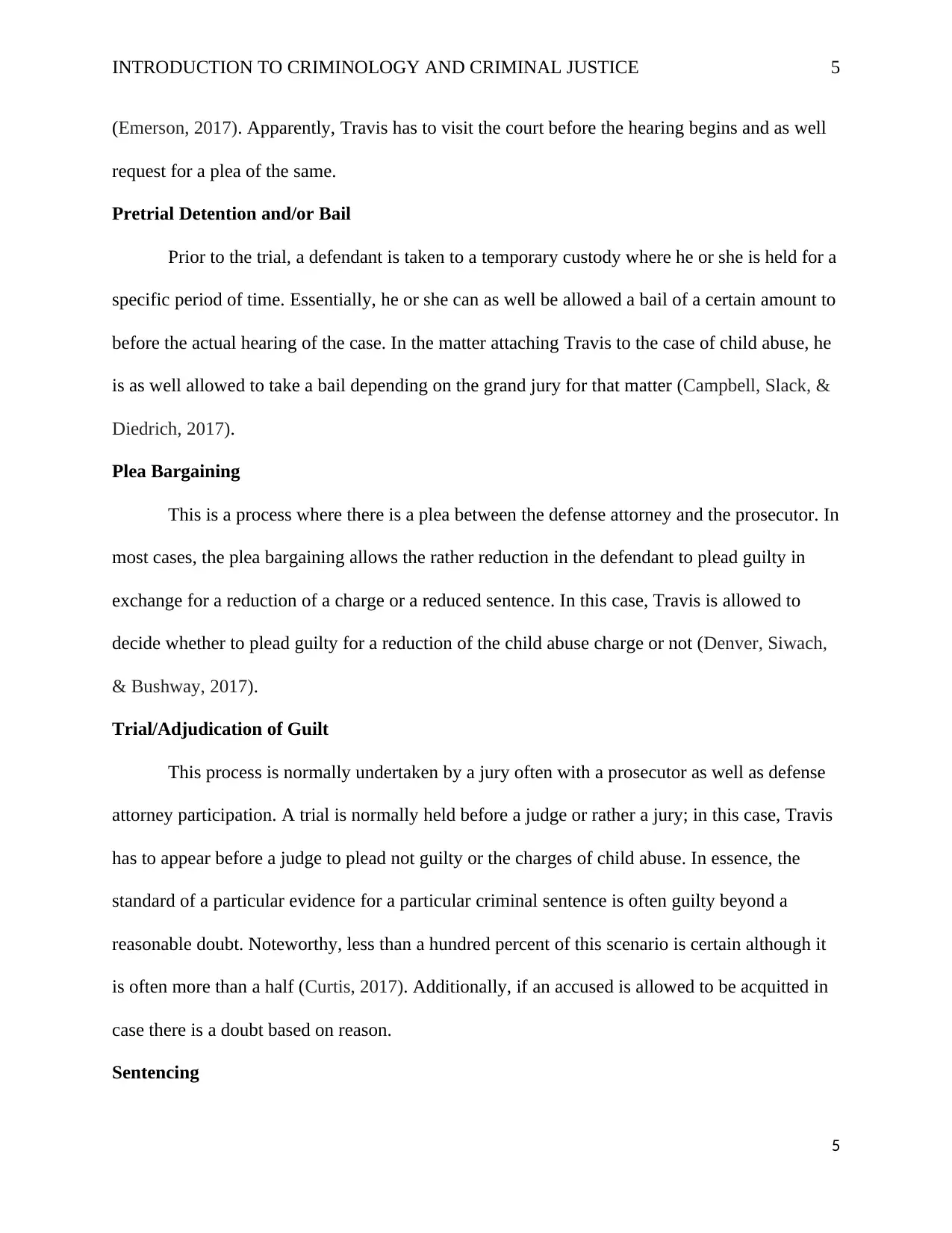
INTRODUCTION TO CRIMINOLOGY AND CRIMINAL JUSTICE 5
(Emerson, 2017). Apparently, Travis has to visit the court before the hearing begins and as well
request for a plea of the same.
Pretrial Detention and/or Bail
Prior to the trial, a defendant is taken to a temporary custody where he or she is held for a
specific period of time. Essentially, he or she can as well be allowed a bail of a certain amount to
before the actual hearing of the case. In the matter attaching Travis to the case of child abuse, he
is as well allowed to take a bail depending on the grand jury for that matter (Campbell, Slack, &
Diedrich, 2017).
Plea Bargaining
This is a process where there is a plea between the defense attorney and the prosecutor. In
most cases, the plea bargaining allows the rather reduction in the defendant to plead guilty in
exchange for a reduction of a charge or a reduced sentence. In this case, Travis is allowed to
decide whether to plead guilty for a reduction of the child abuse charge or not (Denver, Siwach,
& Bushway, 2017).
Trial/Adjudication of Guilt
This process is normally undertaken by a jury often with a prosecutor as well as defense
attorney participation. A trial is normally held before a judge or rather a jury; in this case, Travis
has to appear before a judge to plead not guilty or the charges of child abuse. In essence, the
standard of a particular evidence for a particular criminal sentence is often guilty beyond a
reasonable doubt. Noteworthy, less than a hundred percent of this scenario is certain although it
is often more than a half (Curtis, 2017). Additionally, if an accused is allowed to be acquitted in
case there is a doubt based on reason.
Sentencing
5
(Emerson, 2017). Apparently, Travis has to visit the court before the hearing begins and as well
request for a plea of the same.
Pretrial Detention and/or Bail
Prior to the trial, a defendant is taken to a temporary custody where he or she is held for a
specific period of time. Essentially, he or she can as well be allowed a bail of a certain amount to
before the actual hearing of the case. In the matter attaching Travis to the case of child abuse, he
is as well allowed to take a bail depending on the grand jury for that matter (Campbell, Slack, &
Diedrich, 2017).
Plea Bargaining
This is a process where there is a plea between the defense attorney and the prosecutor. In
most cases, the plea bargaining allows the rather reduction in the defendant to plead guilty in
exchange for a reduction of a charge or a reduced sentence. In this case, Travis is allowed to
decide whether to plead guilty for a reduction of the child abuse charge or not (Denver, Siwach,
& Bushway, 2017).
Trial/Adjudication of Guilt
This process is normally undertaken by a jury often with a prosecutor as well as defense
attorney participation. A trial is normally held before a judge or rather a jury; in this case, Travis
has to appear before a judge to plead not guilty or the charges of child abuse. In essence, the
standard of a particular evidence for a particular criminal sentence is often guilty beyond a
reasonable doubt. Noteworthy, less than a hundred percent of this scenario is certain although it
is often more than a half (Curtis, 2017). Additionally, if an accused is allowed to be acquitted in
case there is a doubt based on reason.
Sentencing
5
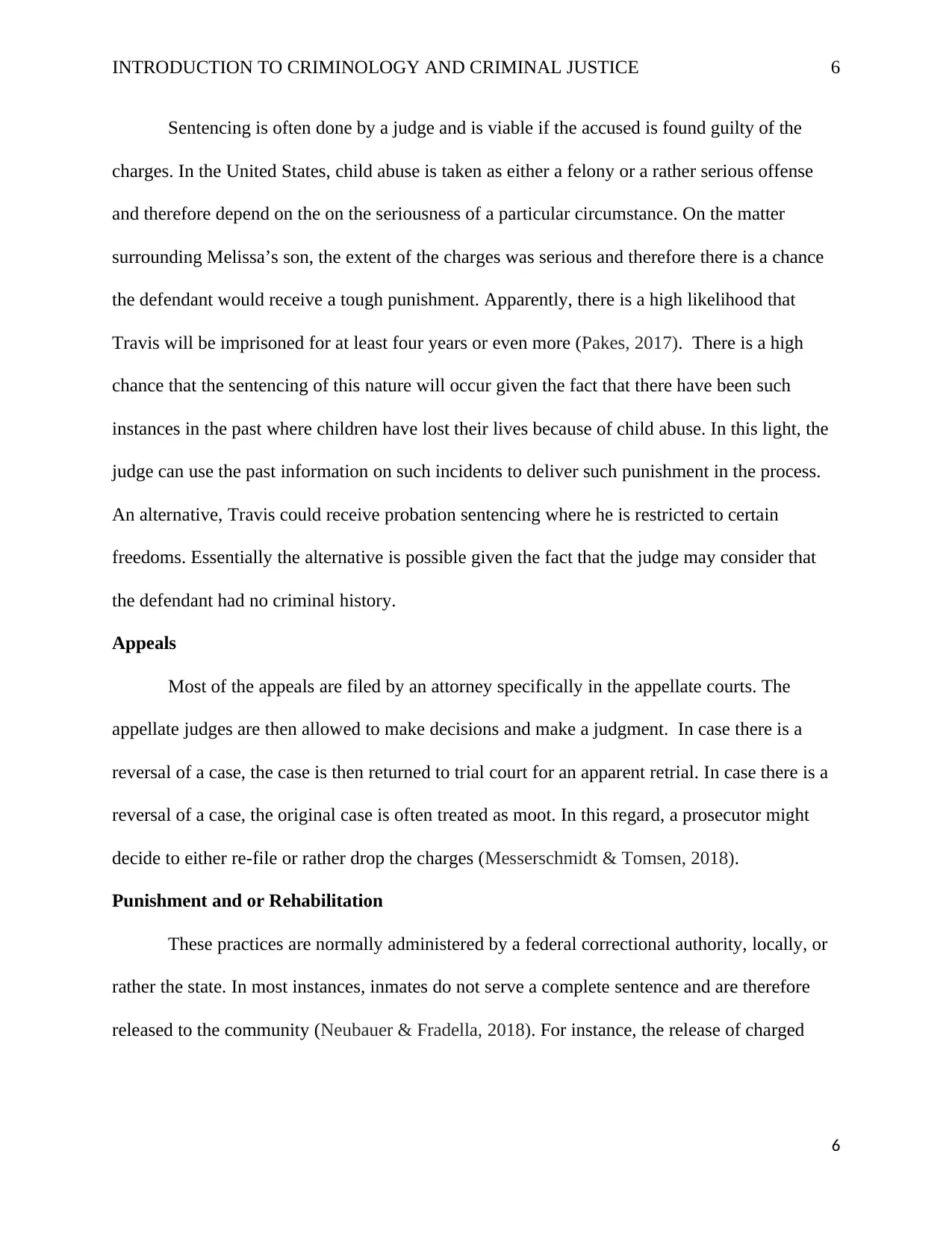
INTRODUCTION TO CRIMINOLOGY AND CRIMINAL JUSTICE 6
Sentencing is often done by a judge and is viable if the accused is found guilty of the
charges. In the United States, child abuse is taken as either a felony or a rather serious offense
and therefore depend on the on the seriousness of a particular circumstance. On the matter
surrounding Melissa’s son, the extent of the charges was serious and therefore there is a chance
the defendant would receive a tough punishment. Apparently, there is a high likelihood that
Travis will be imprisoned for at least four years or even more (Pakes, 2017). There is a high
chance that the sentencing of this nature will occur given the fact that there have been such
instances in the past where children have lost their lives because of child abuse. In this light, the
judge can use the past information on such incidents to deliver such punishment in the process.
An alternative, Travis could receive probation sentencing where he is restricted to certain
freedoms. Essentially the alternative is possible given the fact that the judge may consider that
the defendant had no criminal history.
Appeals
Most of the appeals are filed by an attorney specifically in the appellate courts. The
appellate judges are then allowed to make decisions and make a judgment. In case there is a
reversal of a case, the case is then returned to trial court for an apparent retrial. In case there is a
reversal of a case, the original case is often treated as moot. In this regard, a prosecutor might
decide to either re-file or rather drop the charges (Messerschmidt & Tomsen, 2018).
Punishment and or Rehabilitation
These practices are normally administered by a federal correctional authority, locally, or
rather the state. In most instances, inmates do not serve a complete sentence and are therefore
released to the community (Neubauer & Fradella, 2018). For instance, the release of charged
6
Sentencing is often done by a judge and is viable if the accused is found guilty of the
charges. In the United States, child abuse is taken as either a felony or a rather serious offense
and therefore depend on the on the seriousness of a particular circumstance. On the matter
surrounding Melissa’s son, the extent of the charges was serious and therefore there is a chance
the defendant would receive a tough punishment. Apparently, there is a high likelihood that
Travis will be imprisoned for at least four years or even more (Pakes, 2017). There is a high
chance that the sentencing of this nature will occur given the fact that there have been such
instances in the past where children have lost their lives because of child abuse. In this light, the
judge can use the past information on such incidents to deliver such punishment in the process.
An alternative, Travis could receive probation sentencing where he is restricted to certain
freedoms. Essentially the alternative is possible given the fact that the judge may consider that
the defendant had no criminal history.
Appeals
Most of the appeals are filed by an attorney specifically in the appellate courts. The
appellate judges are then allowed to make decisions and make a judgment. In case there is a
reversal of a case, the case is then returned to trial court for an apparent retrial. In case there is a
reversal of a case, the original case is often treated as moot. In this regard, a prosecutor might
decide to either re-file or rather drop the charges (Messerschmidt & Tomsen, 2018).
Punishment and or Rehabilitation
These practices are normally administered by a federal correctional authority, locally, or
rather the state. In most instances, inmates do not serve a complete sentence and are therefore
released to the community (Neubauer & Fradella, 2018). For instance, the release of charged
6
⊘ This is a preview!⊘
Do you want full access?
Subscribe today to unlock all pages.

Trusted by 1+ million students worldwide

INTRODUCTION TO CRIMINOLOGY AND CRIMINAL JUSTICE 7
persons such as Travis can be through a complete service of the sentence or by a release
mechanism of the form of parole or pardon.
7
persons such as Travis can be through a complete service of the sentence or by a release
mechanism of the form of parole or pardon.
7
Paraphrase This Document
Need a fresh take? Get an instant paraphrase of this document with our AI Paraphraser
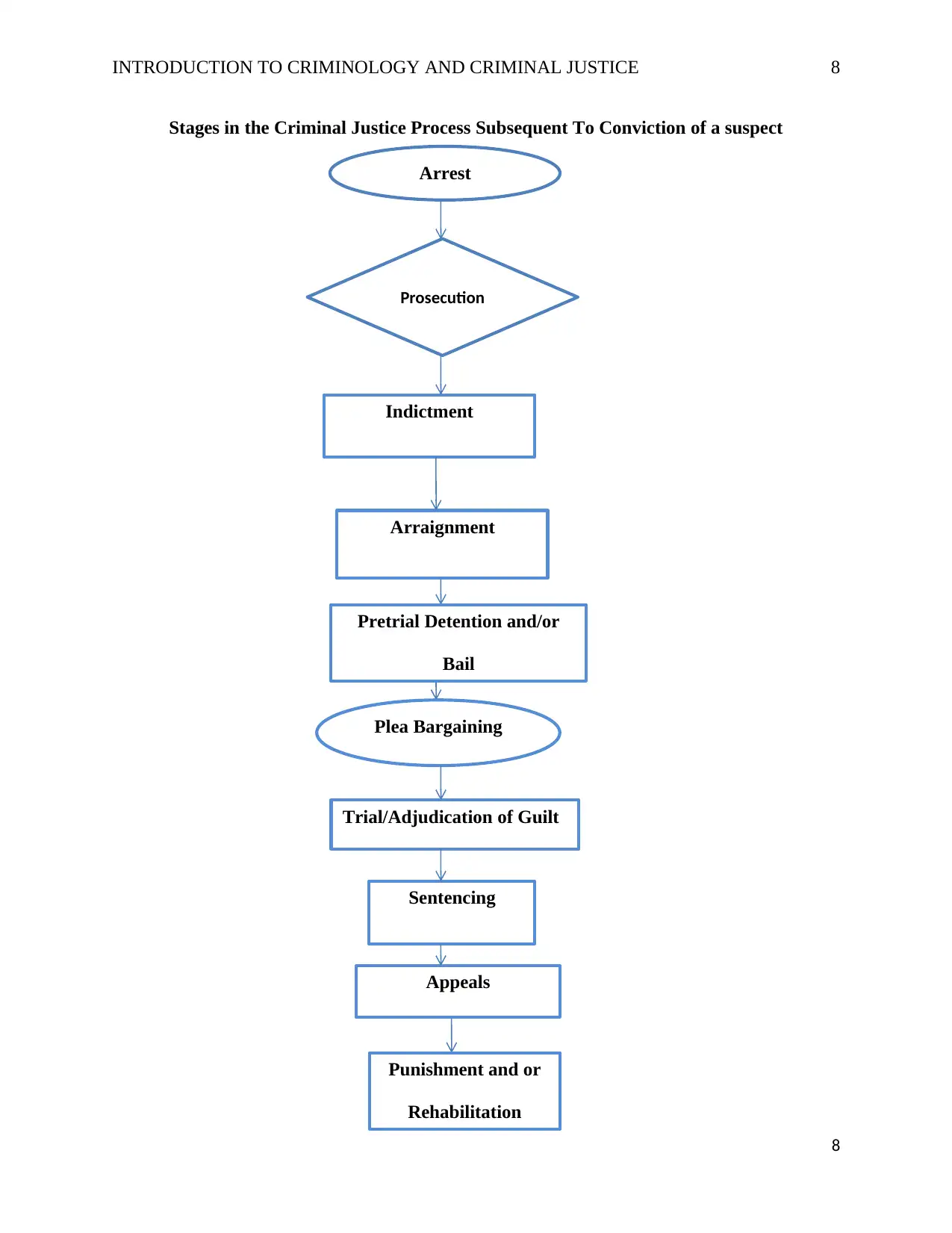
INTRODUCTION TO CRIMINOLOGY AND CRIMINAL JUSTICE 8
Stages in the Criminal Justice Process Subsequent To Conviction of a suspect
8
Arrest
Prosecution
Indictment
Arraignment
Pretrial Detention and/or
Bail
Plea Bargaining
Trial/Adjudication of Guilt
Sentencing
Appeals
Punishment and or
Rehabilitation
Stages in the Criminal Justice Process Subsequent To Conviction of a suspect
8
Arrest
Prosecution
Indictment
Arraignment
Pretrial Detention and/or
Bail
Plea Bargaining
Trial/Adjudication of Guilt
Sentencing
Appeals
Punishment and or
Rehabilitation
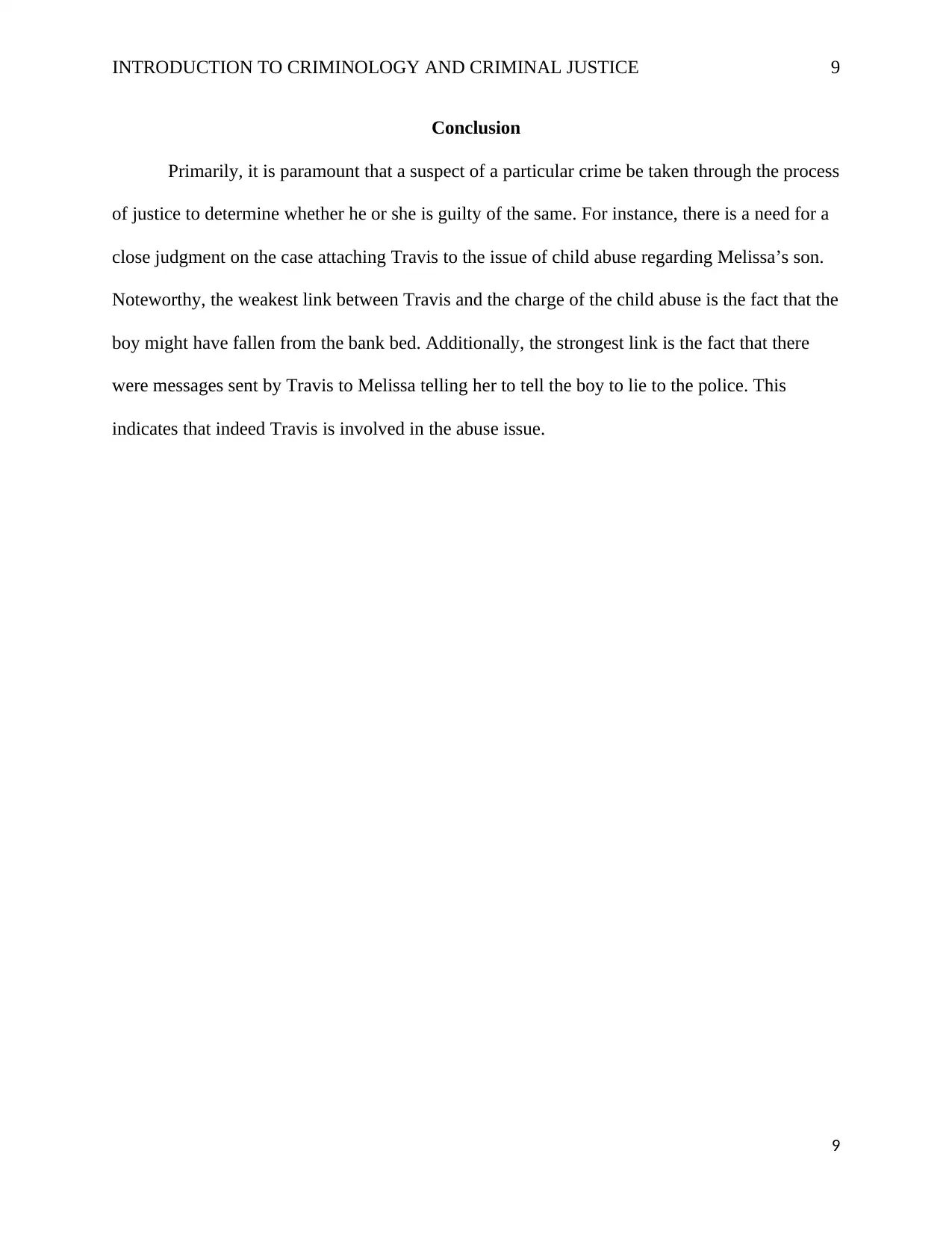
INTRODUCTION TO CRIMINOLOGY AND CRIMINAL JUSTICE 9
Conclusion
Primarily, it is paramount that a suspect of a particular crime be taken through the process
of justice to determine whether he or she is guilty of the same. For instance, there is a need for a
close judgment on the case attaching Travis to the issue of child abuse regarding Melissa’s son.
Noteworthy, the weakest link between Travis and the charge of the child abuse is the fact that the
boy might have fallen from the bank bed. Additionally, the strongest link is the fact that there
were messages sent by Travis to Melissa telling her to tell the boy to lie to the police. This
indicates that indeed Travis is involved in the abuse issue.
9
Conclusion
Primarily, it is paramount that a suspect of a particular crime be taken through the process
of justice to determine whether he or she is guilty of the same. For instance, there is a need for a
close judgment on the case attaching Travis to the issue of child abuse regarding Melissa’s son.
Noteworthy, the weakest link between Travis and the charge of the child abuse is the fact that the
boy might have fallen from the bank bed. Additionally, the strongest link is the fact that there
were messages sent by Travis to Melissa telling her to tell the boy to lie to the police. This
indicates that indeed Travis is involved in the abuse issue.
9
⊘ This is a preview!⊘
Do you want full access?
Subscribe today to unlock all pages.

Trusted by 1+ million students worldwide
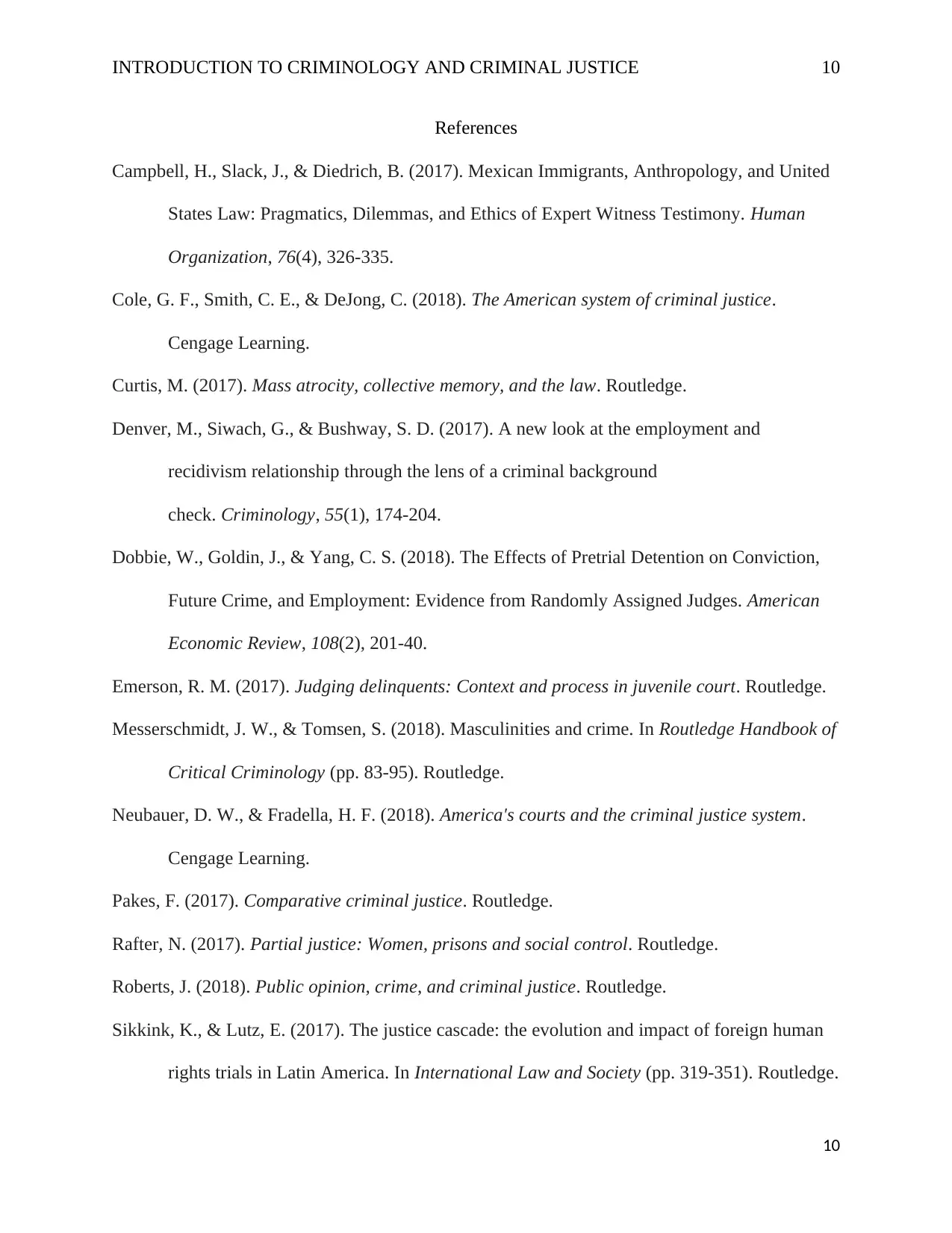
INTRODUCTION TO CRIMINOLOGY AND CRIMINAL JUSTICE 10
References
Campbell, H., Slack, J., & Diedrich, B. (2017). Mexican Immigrants, Anthropology, and United
States Law: Pragmatics, Dilemmas, and Ethics of Expert Witness Testimony. Human
Organization, 76(4), 326-335.
Cole, G. F., Smith, C. E., & DeJong, C. (2018). The American system of criminal justice.
Cengage Learning.
Curtis, M. (2017). Mass atrocity, collective memory, and the law. Routledge.
Denver, M., Siwach, G., & Bushway, S. D. (2017). A new look at the employment and
recidivism relationship through the lens of a criminal background
check. Criminology, 55(1), 174-204.
Dobbie, W., Goldin, J., & Yang, C. S. (2018). The Effects of Pretrial Detention on Conviction,
Future Crime, and Employment: Evidence from Randomly Assigned Judges. American
Economic Review, 108(2), 201-40.
Emerson, R. M. (2017). Judging delinquents: Context and process in juvenile court. Routledge.
Messerschmidt, J. W., & Tomsen, S. (2018). Masculinities and crime. In Routledge Handbook of
Critical Criminology (pp. 83-95). Routledge.
Neubauer, D. W., & Fradella, H. F. (2018). America's courts and the criminal justice system.
Cengage Learning.
Pakes, F. (2017). Comparative criminal justice. Routledge.
Rafter, N. (2017). Partial justice: Women, prisons and social control. Routledge.
Roberts, J. (2018). Public opinion, crime, and criminal justice. Routledge.
Sikkink, K., & Lutz, E. (2017). The justice cascade: the evolution and impact of foreign human
rights trials in Latin America. In International Law and Society (pp. 319-351). Routledge.
10
References
Campbell, H., Slack, J., & Diedrich, B. (2017). Mexican Immigrants, Anthropology, and United
States Law: Pragmatics, Dilemmas, and Ethics of Expert Witness Testimony. Human
Organization, 76(4), 326-335.
Cole, G. F., Smith, C. E., & DeJong, C. (2018). The American system of criminal justice.
Cengage Learning.
Curtis, M. (2017). Mass atrocity, collective memory, and the law. Routledge.
Denver, M., Siwach, G., & Bushway, S. D. (2017). A new look at the employment and
recidivism relationship through the lens of a criminal background
check. Criminology, 55(1), 174-204.
Dobbie, W., Goldin, J., & Yang, C. S. (2018). The Effects of Pretrial Detention on Conviction,
Future Crime, and Employment: Evidence from Randomly Assigned Judges. American
Economic Review, 108(2), 201-40.
Emerson, R. M. (2017). Judging delinquents: Context and process in juvenile court. Routledge.
Messerschmidt, J. W., & Tomsen, S. (2018). Masculinities and crime. In Routledge Handbook of
Critical Criminology (pp. 83-95). Routledge.
Neubauer, D. W., & Fradella, H. F. (2018). America's courts and the criminal justice system.
Cengage Learning.
Pakes, F. (2017). Comparative criminal justice. Routledge.
Rafter, N. (2017). Partial justice: Women, prisons and social control. Routledge.
Roberts, J. (2018). Public opinion, crime, and criminal justice. Routledge.
Sikkink, K., & Lutz, E. (2017). The justice cascade: the evolution and impact of foreign human
rights trials in Latin America. In International Law and Society (pp. 319-351). Routledge.
10
1 out of 10
Your All-in-One AI-Powered Toolkit for Academic Success.
+13062052269
info@desklib.com
Available 24*7 on WhatsApp / Email
![[object Object]](/_next/static/media/star-bottom.7253800d.svg)
Unlock your academic potential
Copyright © 2020–2026 A2Z Services. All Rights Reserved. Developed and managed by ZUCOL.